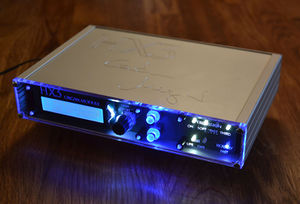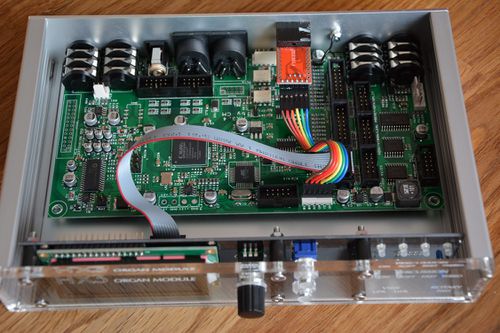HX3 MIDI expander module: Unterschied zwischen den Versionen
Bovist (Diskussion | Beiträge) |
Bovist (Diskussion | Beiträge) K (→Kit Assembly) |
||
| (43 dazwischenliegende Versionen desselben Benutzers werden nicht angezeigt) | |||
| Zeile 1: | Zeile 1: | ||
[[Datei: | [[Datei:expander_vorn.jpg|300 px|thumb|right|'''HX3 Expander''' (special edition "plexi signature" for first 3 customers, other versions will have plain aluminum lid)]] | ||
HX3 MIDI expander is a tonewheel organ with all B3 features in a small box! Controlled completely via MIDI, selectable CC-sets for NI B4, Hammond XK, Hamichord and other. 30 presets (to be stored locally), many "secret" HX3 parameters tweakable by menu with incremental encoder - like key contact flex and damping for key click response, or AO28 gain adjustments for more or less percussion punch etc. And, of course, it yields the legendary unmatched HX3 sound. | |||
HX3 | OEMs/Resellers will receive an HX3 Expander in kit form on request -- see assembly instructions below. | ||
==Features== | ==Features== | ||
* Compact organ emulator module in aluminum box, | * Compact organ emulator module in aluminum box, 222 x 150 x 42 mm | ||
* Authentic reproduction of generator, tapering, key contacts, percussion and vibrato by FPGA (Field Programmable Gate Array) | * Authentic reproduction of generator, tapering, key contacts, percussion and vibrato by FPGA (Field Programmable Gate Array) | ||
* Extremely low latency of 50 microseconds Key-to-Audio ( | * Extremely low internal latency of 50 microseconds Key-to-Audio (see note below) | ||
* Natural key click by "rattling" contacts | * Natural key click by "rattling" contacts | ||
* Accurate Leslie simulation with separate | * Accurate Leslie simulation with separate 122 amp output | ||
* MIDI IN accepts 5 different MIDI CC sets | * MIDI IN accepts 5 different MIDI CC sets | ||
* 7 LEDs show vibrato and percussion setting | * 7 LEDs show vibrato and percussion setting | ||
* LCD display and menu system with 2x16 presets, virtual drawbars and parameter tuning | * LCD display and menu system with 2x16 presets, virtual drawbars and parameter tuning | ||
* Swell (expression) pedal and footswitch jacks | * Swell (expression) pedal and footswitch jacks | ||
* Built-in DSP reverb with 3 different reverb algorithms | |||
* DC input 9 to 12V, 500 mA min. | |||
'''[https://github.com/keyboardpartner/HX3/blob/master/DOCS_PDF/HX3%20MIDI%20expander%20module.pdf?raw=true User Manual download (PDF)]''' | |||
'''[[HX3 Remote Application]]''' for firmware updates and parameter tweaking | |||
== Kit Assembly == | == Kit Assembly == | ||
* Install HX3 | '''For OEMs and resellers the HX3 MIDI Expander is available as a pre-assembled kit.''' | ||
* Use M3 screw, locking washer and M3 nut to fasten the | |||
[[Datei:Expander innen.JPG|500px|thumb|right|'''HX3 Expander with mk4 board, inside view. Note ground lug connection and USB interface cabling.''']] | |||
You will need a Philips #1 screwdriver, a 2mm Allen wrench, a 2.5mm Allen wrench and a 5.5mm wrench nut to build. The HX3 expander kit comes with fully functional boards, front and rear bezel/panel, cables, screws and aluminum enclosure. | |||
* Install HX3 mainboard to rear panel. The 4 jack nuts hold the entire board. Place rubber toe on back of PCB near PL26 (white 6-pin header). | |||
* Use M3 screw, locking washer and M3 nut to fasten the ground lug to back panel. Locking washer is placed inside on aluminum panel. | |||
* Remove protective film from LCD just prior to final installation. | * Remove protective film from LCD just prior to final installation. | ||
* Fasten MenuDisplay board to front panel using 6 M3 | * Fasten MenuDisplay board to front plexi panel using 6 M3 Allen screws with 6 plastic spacers and M3 nuts. Do not overtighten screws to prevent cracks in bezel. Use locking washers on each M3 nut. | ||
* Fasten side panels to | * Fasten side panels to back panel using 4 self-tapping Philips screws. | ||
* Insert bottom panel into slots of side panel. | * Insert bottom panel into slots of side panel. | ||
* | * Mount USB interface board with short self-tapping screw so USB connector is straight in slot. | ||
* | * Connect USB interface to HX3 PL26 with short coloured jumper wires. Do not cross cables, use straight one-on-one connection. | ||
* | * Connect MenuPanel with flat-ribbon cable to HX3 board PL4. | ||
* Fasten side panels to | * Insert top lid. | ||
* Fasten side panels to front panel using 4 Allen type M3x12mm screws. Do not overtighten screws to prevent cracks in bezel. | |||
* Affix 4 self-adhesive bases to bottom panel in each corner. | * Affix 4 self-adhesive bases to bottom panel in each corner. | ||
You're done! Time to try out: Plug in appropriate power supply 9 to 12V 800mA min. to DC jack. Display will illuminate and show welcome message, serial number and owner information (your name per default). Turn knob to select a preset. LEDs on right side will show corresponding vibrato/percussion setting. | You're done! Time to try out: Plug in appropriate power supply 9 to 12V 800mA min. to DC jack. Display will illuminate and show welcome message, serial number and owner information (your name per default). Turn knob to select a preset. LEDs on right side will show corresponding vibrato/percussion setting. | ||
Aktuelle Version vom 27. Juli 2015, 10:00 Uhr
HX3 MIDI expander is a tonewheel organ with all B3 features in a small box! Controlled completely via MIDI, selectable CC-sets for NI B4, Hammond XK, Hamichord and other. 30 presets (to be stored locally), many "secret" HX3 parameters tweakable by menu with incremental encoder - like key contact flex and damping for key click response, or AO28 gain adjustments for more or less percussion punch etc. And, of course, it yields the legendary unmatched HX3 sound.
OEMs/Resellers will receive an HX3 Expander in kit form on request -- see assembly instructions below.
Features
- Compact organ emulator module in aluminum box, 222 x 150 x 42 mm
- Authentic reproduction of generator, tapering, key contacts, percussion and vibrato by FPGA (Field Programmable Gate Array)
- Extremely low internal latency of 50 microseconds Key-to-Audio (see note below)
- Natural key click by "rattling" contacts
- Accurate Leslie simulation with separate 122 amp output
- MIDI IN accepts 5 different MIDI CC sets
- 7 LEDs show vibrato and percussion setting
- LCD display and menu system with 2x16 presets, virtual drawbars and parameter tuning
- Swell (expression) pedal and footswitch jacks
- Built-in DSP reverb with 3 different reverb algorithms
- DC input 9 to 12V, 500 mA min.
HX3 Remote Application for firmware updates and parameter tweaking
Kit Assembly
For OEMs and resellers the HX3 MIDI Expander is available as a pre-assembled kit.
You will need a Philips #1 screwdriver, a 2mm Allen wrench, a 2.5mm Allen wrench and a 5.5mm wrench nut to build. The HX3 expander kit comes with fully functional boards, front and rear bezel/panel, cables, screws and aluminum enclosure.
- Install HX3 mainboard to rear panel. The 4 jack nuts hold the entire board. Place rubber toe on back of PCB near PL26 (white 6-pin header).
- Use M3 screw, locking washer and M3 nut to fasten the ground lug to back panel. Locking washer is placed inside on aluminum panel.
- Remove protective film from LCD just prior to final installation.
- Fasten MenuDisplay board to front plexi panel using 6 M3 Allen screws with 6 plastic spacers and M3 nuts. Do not overtighten screws to prevent cracks in bezel. Use locking washers on each M3 nut.
- Fasten side panels to back panel using 4 self-tapping Philips screws.
- Insert bottom panel into slots of side panel.
- Mount USB interface board with short self-tapping screw so USB connector is straight in slot.
- Connect USB interface to HX3 PL26 with short coloured jumper wires. Do not cross cables, use straight one-on-one connection.
- Connect MenuPanel with flat-ribbon cable to HX3 board PL4.
- Insert top lid.
- Fasten side panels to front panel using 4 Allen type M3x12mm screws. Do not overtighten screws to prevent cracks in bezel.
- Affix 4 self-adhesive bases to bottom panel in each corner.
You're done! Time to try out: Plug in appropriate power supply 9 to 12V 800mA min. to DC jack. Display will illuminate and show welcome message, serial number and owner information (your name per default). Turn knob to select a preset. LEDs on right side will show corresponding vibrato/percussion setting.

